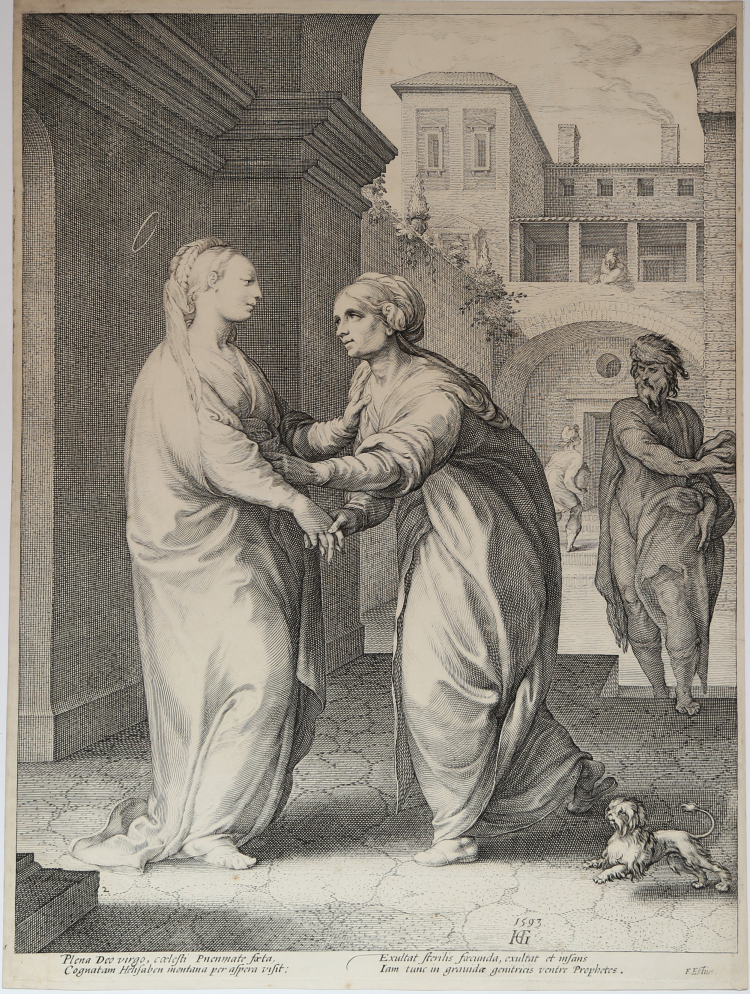



| Reference: | S36079.2 |
| Author | Hendrick GOLTZIUS |
| Year: | 1593 |
| Measures: | 351 x 460 mm |


| Reference: | S36079.2 |
| Author | Hendrick GOLTZIUS |
| Year: | 1593 |
| Measures: | 351 x 460 mm |
Engraving, 1593, signed with monogram and dated at lower right in the image 1593/HG”. Third state, of five, with the verses by F. Estius and the numberal 2 added on the lower right
Magnificient example, printed on contemporary laid paper, with “Fleur-de-lis and Arms of Strasbourg” (similar to Briquet 22244), thin margins, occasional and light foxing at lower side, paper fold in the lower side of the image, generally in very good condition.
This is the second scene from The Life of Virgin.She is shown visiting Elizabeth. Joseph (?) is approaching from the rear.
Like the "Holy Family with Saint John" this sheet was executed in 1593 and therefore predates the "Annunciation" of 1594, inexplicably reversing the order of the narrative.
Continuing the practice of patterning each scene on the style of an earlier master, Goltzius unmistakably based this one on Parmigianino. Hirschmann describes the Visitation" as "less magnificent" than the "Annunciation." He points out that the representation fails to convey the deeper meaning of the event. "They are merely two tall, richly robed women, reminiscent of [Goltzius] Muses, with the same outward complaisance and lack of inner meaning. The one figure is light and placed on a dark background, the other is dark contrasted with white areas.". Tempering his criticism, Hirschmann places at least part of the blame on Parmigianino's style.
Collection mark of Albert Van Look (L.3752) on verso.
|
Bartsch, 16; Strauss, n. 318 p. 576
|
Hendrick GOLTZIUS (Mulbrecht 1559 - Haarlem 1617)
|
Dutch painter and engraver, was born at Millebrecht, in the duchy of Julich.
After studying painting on glass for some years under his father, he was taught the use of the burin by Dirk Volkertszoon Coornlert, a Dutch engraver of mediocre attainment, whom he soon surpassed, but who retained his services for his own advantage. He was also employed by Philip Galle to engrave a set of prints of the history of Lucretia.
At the age of twenty-one he married a widow somewhat advanced in years, whose money enabled him to establish at Haarlem an independent business; however his unpleasant relations with her so affected his health that he found it advisable in 1590 to make a tour through Germany to Italy, where he acquired an intense admiration for the works of Michelangelo, which led him to surpass that master in the grotesqueness and extravagance of his designs. He returned to Haarlem considerably improved in health, and laboured there at his art till his death.
Goltzius ought not to be judged chiefly by the works he valued most, his eccentric imitations of Michelangelo. His portraits, though mostly miniatures, are master-pieces of their kind, both on account of their exquisite finish, and as fine studies of individual character. Of his larger heads, the life-size portrait of himself is probably the most striking example. His master-pieces, so called from their being attempts to imitate the style of the old masters, have perhaps been overpraised.
In his command of the burin Goltzius is not surpassed even by Dürr; but his technical skill is often unequally aided by higher artistic qualities. Even, however, his eccentricities and extravagances are greatly counterbalanced by the beauty and freedom of his execution. He began painting at the age of forty-two, but none of his works in this branch of art--some of which are in the imperial collection at Vienna--display any special excellences. He also executed a few pieces in chiaroscuro.
|
|
Bartsch, 16; Strauss, n. 318 p. 576
|
Hendrick GOLTZIUS (Mulbrecht 1559 - Haarlem 1617)
|
Dutch painter and engraver, was born at Millebrecht, in the duchy of Julich.
After studying painting on glass for some years under his father, he was taught the use of the burin by Dirk Volkertszoon Coornlert, a Dutch engraver of mediocre attainment, whom he soon surpassed, but who retained his services for his own advantage. He was also employed by Philip Galle to engrave a set of prints of the history of Lucretia.
At the age of twenty-one he married a widow somewhat advanced in years, whose money enabled him to establish at Haarlem an independent business; however his unpleasant relations with her so affected his health that he found it advisable in 1590 to make a tour through Germany to Italy, where he acquired an intense admiration for the works of Michelangelo, which led him to surpass that master in the grotesqueness and extravagance of his designs. He returned to Haarlem considerably improved in health, and laboured there at his art till his death.
Goltzius ought not to be judged chiefly by the works he valued most, his eccentric imitations of Michelangelo. His portraits, though mostly miniatures, are master-pieces of their kind, both on account of their exquisite finish, and as fine studies of individual character. Of his larger heads, the life-size portrait of himself is probably the most striking example. His master-pieces, so called from their being attempts to imitate the style of the old masters, have perhaps been overpraised.
In his command of the burin Goltzius is not surpassed even by Dürr; but his technical skill is often unequally aided by higher artistic qualities. Even, however, his eccentricities and extravagances are greatly counterbalanced by the beauty and freedom of his execution. He began painting at the age of forty-two, but none of his works in this branch of art--some of which are in the imperial collection at Vienna--display any special excellences. He also executed a few pieces in chiaroscuro.
|